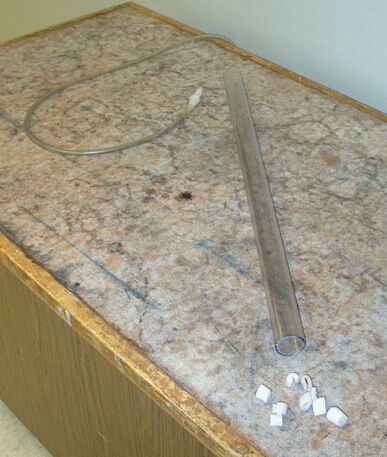
Place the bottom opening of the clear plastic tube a couple of inches above a pile of styrofoam “peanuts.” Place the hose nozzle near the top opening, and blow the air stream across it. The peanuts will rise up into the tube, come through it, and then pop out of the top end. You will need to use some care, because if you blow air into the tube, the peanuts will scatter. You must make sure that the flow is across the tube opening, perpendicular to the tube.
What is happening?
The physics of this system is explained by Bernoulli’s theorem, which describes the steady flow of a nonviscous, incompressible fluid. It states that
p + (1/2)ρv2 + ρgy = constant.
(Some people might be used to seeing this equation stated as (p/ρ) + (1/2)v2 + φ = constant, where φ = gy.) This is strictly true only for flow along a particular streamline of the fluid. If, however, we make the additional simplification that the flow is irrotational, then it applies for flow at any point in the fluid. This equation contains the sum of the static pressure, the pressure that would be present even if there were no flow, which is p + ρgy, and the dynamic pressure, (1/2)ρv2, which arises from the fluid flow. A note on its derivation follows the explanation of the demonstration.
When you flow air across the opening of the pipe, the static pressure in the flowing air (perpendicular to its flow) is lower than the pressure of the stagnant air surrounding it. The pressure in the pipe and at the bottom end of the pipe, then, is greater than the pressure at the top end, which causes air to flow into the bottom end of the pipe. If you hold the bottom end of the pipe near the styrofoam peanuts, these become entrained in the air flow into the pipe. Thus, they rise into the pipe, travel upwards and pop out of the top end.
One can arrive at the Bernoulli equation in one of at least two ways. It arises from a formal mathematical treatment of the equations of motion for a fluid, which are similar to those for electrodynamics. Since it is essentially a statement of the conservation of energy, one can also derive it by means of the work-energy theorem. We can envision fluid flowing through a tube with an entrance having a particular cross-sectional area, A1, and an exit at a different height, with an area A2. If we consider a particular volume of fluid at the entrance and at the exit, these correspond to a length l1 at the entrance and l2 at the exit. If we call the entrance pressure p1, the exit pressure p2, and the entrance and exit heights y1 and y2, respectively, we can calculate the total work done on the fluid (by the sum of pressure and gravitational forces) as p1A1l1 - p2A2l2 - mg(y2 - y1). The product of area and length is volume, which we can also write as m/ρ, so this becomes (p1 - p2)(m/ρ) - mg(y2 - y1). By the work-energy theorem, this work must equal the kinetic energy change for the volume element, which we can express as (1/2)mv22 - (1/2)mv12. Equating these gives:
(p1 - p2)(m/ρ) - mg(y2 - y1) = (1/2)mv22 - (1/2)mv12,
which we can rearrange as p1 + (1/2)ρv12 + ρgy1 = p2 + (1/2)ρv22 + ρgy2. Since the subscripts can refer to any two points along the tube, we can drop them and replace the right side of this equation with a constant to give the Bernoulli equation as stated above.
References:
1) Feynman, Richard P., Leighton, Robert B. and Sands, Matthew. The Feynman Lectures on Physics, Volume II, Mainly Electromagnetism and Matter (Reading, Massachusetts: Addison-Wesley Publishing Company, 1963) 40-2 to 40-9.
2) Resnick, Robert and Halliday, David. Physics, Part One, Third Edition (New York: John Wiley and Sons, 1977), pp. 386-391.